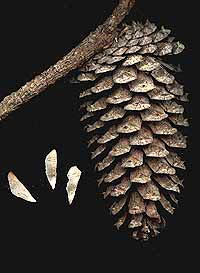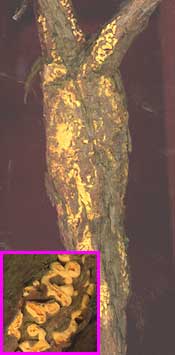Excerpts from Jim Conrad's
Naturalist Newsletter
from the November 2, 2003 Newsletter issued from the woods near Natchez, southwestern Mississippi, USA
LOBLOLLY PINE SEEDS FALLING
 It was chilly early this week but by Thursday it got into the 80s (+27°C). Dry warmth caused the cones of Loblolly Pines to open, and stiff breezes shook out the seeds. Sometimes so many straw-colored seeds swirled onto the barn's tin roof that it sounded like a shower beginning. As the seeds fell, they spun like maple fruits, the ones kids call "helicopters." You can see a Loblolly Pine cone and seeds on my page at the right.
It was chilly early this week but by Thursday it got into the 80s (+27°C). Dry warmth caused the cones of Loblolly Pines to open, and stiff breezes shook out the seeds. Sometimes so many straw-colored seeds swirled onto the barn's tin roof that it sounded like a shower beginning. As the seeds fell, they spun like maple fruits, the ones kids call "helicopters." You can see a Loblolly Pine cone and seeds on my page at the right.
Loblolly seedlings in our Loblolly Field grow so fast, so promiscuously, and their wood is so soft that I think of Loblolly saplings almost as big weeds. When I clear garden spots I just walk up to a 15-ft-high Loblolly, bend it over with an arm, and two or three chops with my machete take it down. A thirty-year-old Loblolly, however, starts having a bit of character. Its thick, black limbs droop and grow gnarly, and its dark-brown bark fractures into irregular, scaly blocks. A large Loblolly is as impressive as its glossy, spindly saplings are unimpressive.
That word "Loblolly" is a good one, and etymologists have at least part of a good story for it. The "lob," they say, is "probably an onomatopoeia for the thick heavy bubbling of cooking porridge." "Lolly," they claim, is an old British dialect word for broth, soup, or any other food boiled in a pot. Thus originally the word was applied to a thick porridge. In the US Southeast, people began calling mudholes loblollies because of their messy stickiness. But at this point the story becomes uncertain as to how mudhole loblollies became associated with our Loblolly Pines, PINUS TAEDA. One etymological theory is that Loblolly Pines favor wet bottomlands or swamps where mudhole loblollies are apt to occur. However, you've seen that Loblollies are nowhere more at home than in our dry, upland abandoned fields.
from the March 23, 2003 Newsletter issued from the woods near Natchez, southwestern Mississippi, USA
FUSIFORM RUST ON LOBLOLLY PINE
 For a year or so I've been watching a couple of swellings halfway up the 20-ft high (6 m) Loblolly Pine right behind my trailer. This week the growths developed strikingly orange-yellow blisters. Since my Loblolly is in a bad place and it'll probably die anyway, I cut an infected branch bearing an infection, scanned it, and you can see that image at the right.
For a year or so I've been watching a couple of swellings halfway up the 20-ft high (6 m) Loblolly Pine right behind my trailer. This week the growths developed strikingly orange-yellow blisters. Since my Loblolly is in a bad place and it'll probably die anyway, I cut an infected branch bearing an infection, scanned it, and you can see that image at the right.
The infection is known as Fusiform Rust and it's caused by the fungus CRONARTIUM QUERCUUM. It's a serious disease for Loblolly and Slash Pines in the US Southeast. Infections occurring on the main stem within a tree's first 5 years normally cause the tree to die. My Loblolly Pine is about five years old. Infections occurring on older trees cause weakened stems and trunks that often snap during storms.
This is a fascinating disease, especially because during its life cycle it bounces between pines and oaks. Right now when you knock against my Loblolly's trunk a cloud of orange powder is released from the blisters. This powder is composed of tiny aeciospores. These aeciospores land on oak leaves and later in spring pustules known as uredia will appear on the oak leaves' undersurfaces. During late spring or early summer, brown, hairlike structures called telia will form on the oak leaves. These telia will produce teliospores which will germinate into basidiospores, which will infect a pine and cause a new infection like the one behind my trailer.